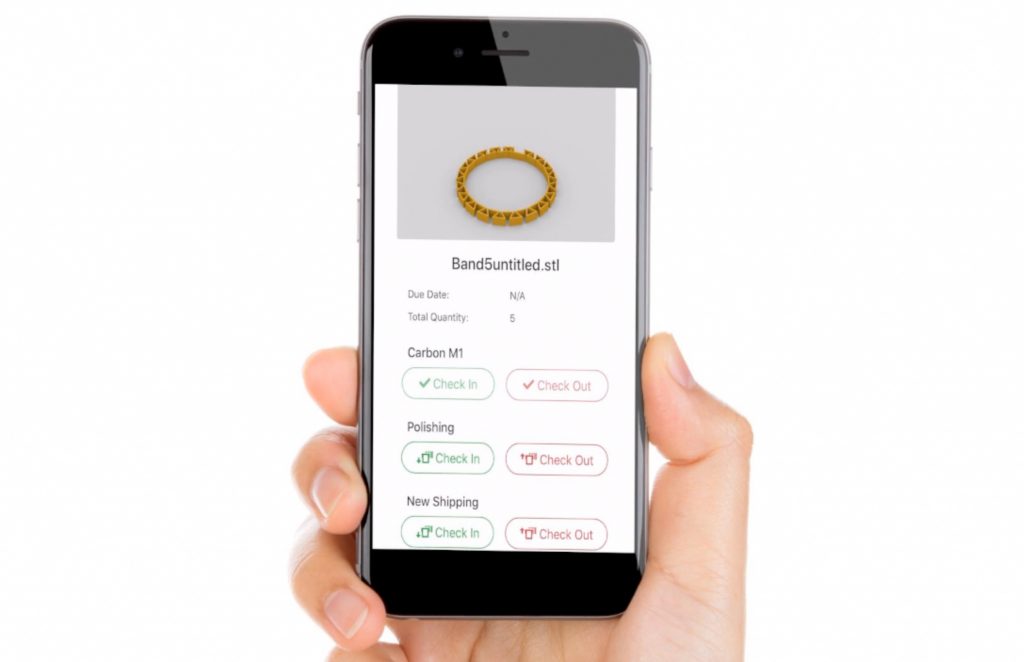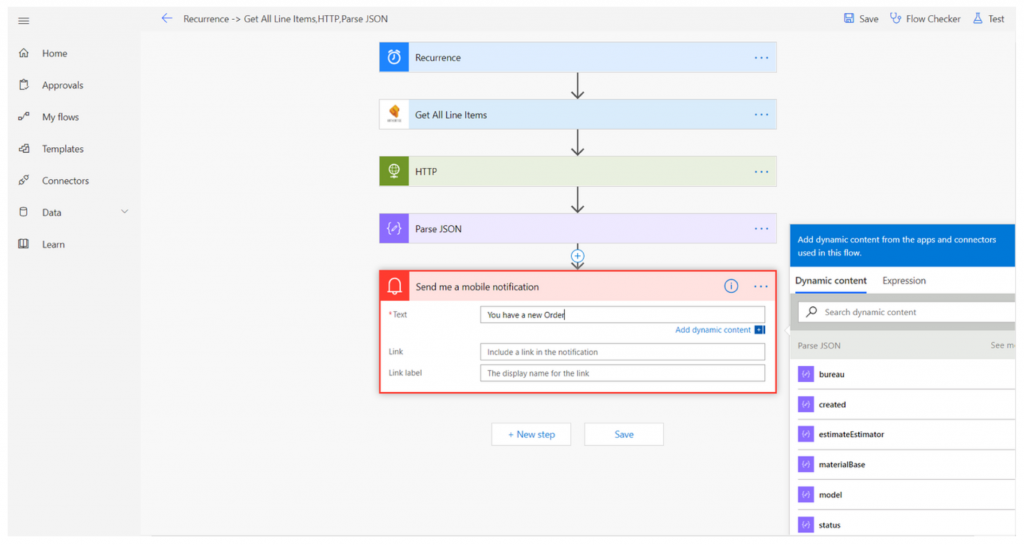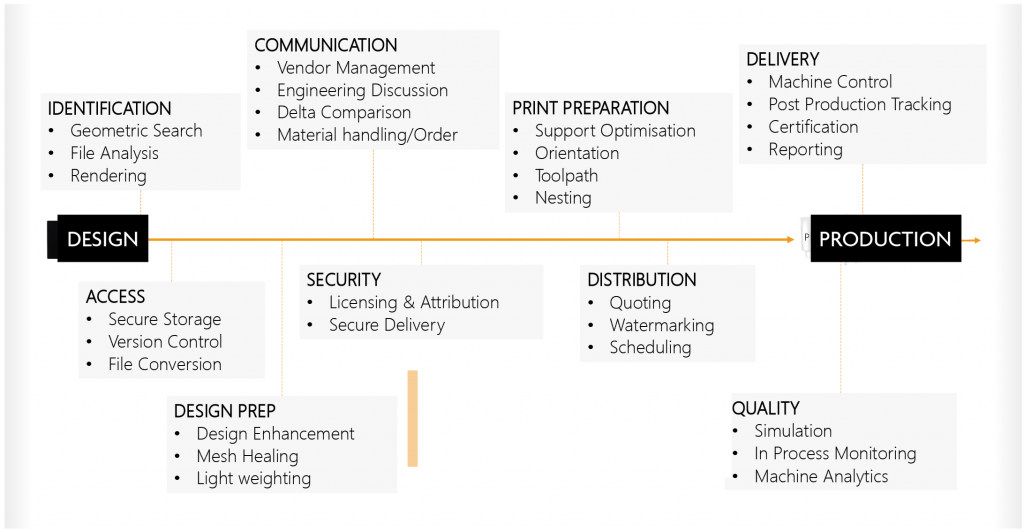Defining your digital future: The path to industrial digitalisation in Additive Manufacturing and beyond
Terms such as Industry 4.0, the Digital Thread and the Digital Twin have become familiar buzzwords in manufacturing, but many such terms barely make sense to IT experts, let alone AM professionals. In the crowded and jargon-heavy landscape of solutions for digitalisation, articulating future AM software trends can help offer clarity and confidence in IT investments and give insight into the data-driven future of manufacturing, believes Authentise’s Andre Wegner, who shares his vision of the route to developing an effective digital factory with Metal AM’s Emily-Jo Hopson. [First published in Metal AM Vol. 5 No. 2, Summer 2019 | 20 minute read | View on Issuu | Download PDF]

Authentise, based in Mountain View, California, USA, has come a long way from its roots in security and intellectual property protections for AM to establish itself as a leading software and service provider driving the development of connected, modular and open workflow tools for industry.
Founded in 2012 by Andre Wegner, a frequent author and speaker as well as Chair of Digital Manufacturing at the nearby Singularity University, the company’s workflow solutions aim to tie all data generated during the AM process together and leverage that data to reduce effort and increase productivity, repeatability and traceability. Application of the technology is no longer limited to the Additive Manufacturing industry, but is regarded as a model for the intelligent digitalisation of manufacturing as a whole.
Drawing on the expertise of a team of subject matter experts which includes management consultants, engineers, solution architects and product design officers, Authentise has the knowledge and experience to determine the greatest threats and opportunities posed by digital manufacturing, and understand its impact across the manufacturing segment. To address these threats and opportunities, the company offers specialised software solutions to facilitate the effective digitalisation of manufacturing workflows.

In order to effectively tie the stages of the AM process together, a significant degree of Authentise’s efforts have focused on the development of partnerships and integrations with major machine vendors, CAD vendors and business tool developers to enable the gathering and consolidation of all data in the manufacturing process. This can then be leveraged to optimise workflow.
Among those applications available as part of the company’s modular 3DIAX workflow management tool are multiple third party systems – many of them competitors – selected to ensure that users have easy access to best in class systems without the need to learn and understand new interfaces. They include mesh healing tools by Materialise, Autodesk and MX3D, shape search technology by Siemens, file conversion and serialisation solutions by Prototech and more.
Even though Authentise has developed its own machine learning-based quoting software, users of the platform can also access estimates by Prosper, an Israeli startup, and can thus easily switch provider at any time.
Over the last year, a series of significant announcements have offered further insight into how the company’s development strategy is unfolding. Late last year, a partnership with Autodesk was announced on an integration that makes it possible to use Autodesk Netfabb®, a leading brand in software for Additive Manufacturing design, seamlessly within 3DIAX. This integration means that geometries can be loaded directly into Netfabb from Authentise at the press of a button, and files edited in Netfabb exported back into Authentise’s suite just as simply, enabling the development of an integrated workflow which includes quoting, CAD editing, version control, scheduling and real-time data-driven monitoring.
More recently, Authentise agreed to a multi-year collaboration with Microsoft which will enable it to utilise Microsoft Azure, a cloud computing service for building, testing, deploying and managing applications and services through Microsoft-managed data centres, and integrate Authentise’s solutions into Microsoft Flow, Microsoft’s workflow automation platform. The integration with Flow gives operators direct access to Authentise’s system via the Microsoft Flow Gallery, and allows them the opportunity to create their own process automations regardless of the level of their coding knowledge.
Flow also allows operators to connect Authentise’s data with third party applications such as Microsoft Office 365, Quickbooks, text messaging, email and more, by simply dragging and dropping the operations into place. In doing so, they can create custom alerts, dashboards and other workflow automations to further increase transparency and efficiency in their Additive Manufacturing operations.

Authentise recently received United States Patent and Trademark Office (USPTO) approval on its patent, ‘System, Method and Program Product for Digital Production Management.’ The patent shows how streaming designs or machine code directly into manufacturing devices (down the PLCs that control the individual movements within the machine, eventually) can help not only to protect the intellectual property of the part but also enable remote integrity control (by monitoring the feedback remotely) and close the loop completely by making remote in-process amendments, such as integrating watermarks in the object once it has been verified that the part was produced correctly.
This technology is available in the company’s data-driven Additive Accelerator workflow management solution and, while Wegner stated at the time of the announcement that Authentise is, “in the technology game, not the patent game,” the company believes that the patent “shows a path for the future of manufacturing,” adding: “We see this patent as a shining ad to the industry as to where the technology is moving. To get there, we have to work together with others. To work with others, we have to show them there’s value in it. That we think there’s enough value to file a patent.”
Making sense of today’s AM software trends
Recently, Wegner shared his thoughts with Metal AM magazine’s Emily-Jo Hopson on the future of manufacturing in the digital age, and on the ways in which he believes that articulating future AM software trends can help offer certainty in IT investments and insight into the data-driven future of the manufacturing industry.
Terms such as Industry 4.0, Digital Thread and Digital Twin have become familiar buzzwords in manufacturing, but many of them, according to Wegner, barely make sense to IT experts, let alone AM professionals, who are typically more focused on identifying applications, characterising materials and optimising production.
What IT experts such as Authentise can offer, however, is an understanding of current realities and the experience to know where trends are heading. Using this experience to crystalise a vision for digitalisation can help manufacturers – not just in AM, but in a number of fields – plan how to structure their IT investments today, as well as providing guidance on how to relate to data and software in the years to come.
Drawing on his background both in the Additive Manufacturing industry and the academic field of future studies, Wegner highlighted three key long-term trends he sees in software and data for AM.
1. Generative design from initial idea to the finished part
Generative design has become increasingly important in Additive Manufacturing in recent years. In this iterative design process, a program generates a number of outputs in order to meet set constraints. While in concept generative design can be practised by a human with nothing more than pen and paper, the term is mostly used to refer to a specific kind of CAD, in which an artificial intelligence automatically generates these outputs, enabling designers to explore a very large number of possible permutations of design solution to meet a particular problem.
As new programming environments and scripting capabilities make it relatively easy for designers to implement their ideas via generative design, this process is becoming ever more important, especially in fields such as AM where new design freedoms are available which would not be possible with conventional manufacturing methods. Generative design solutions are now being incorporated in CAD packages offered by major software companies such as Autodesk and Altair.
However, there is still progress to be made until generative design is fully established as a usable, everyday solution for the digital factory, Wegner noted, stating that, “The promise of generative design has so far resulted in little more than demo reels. Optimising areas of more limited constraints such as support, orientation and nesting will be the first step for these algorithms and is already saving operators time.”
While much remains to be done to get to a fully automated design process, he believes that the determination with which the technology is being pursued at Autodesk, Altair and beyond shows that companies are taking its disruptive potential seriously. “With resources at our disposal, and decades of learning from simulation, model-based design and associated fields backing us, we can talk confidently about where the generative trajectory leads us,” he explained. “A future in which a part might be shaped by digital constraints from consumers, the environment, manufacturing processes and beyond, only to be assembled into its final geometric shape at the very last moment.”
2. Seamless workflows
“It is no exaggeration to say that users are upset with the current glut of software tools they must use to make parts work,” Wegner noted, “particularly at the high end of additive: simulation, support optimisers, engineering tools, materials databases, toolpath generators, workflow, in-process monitoring tools and others. The list goes on. Each tool has a separate interface, often by widely different companies with significant licence fees attached. Knowing which to pick and learn is a challenge, especially when a new, better tool might be just around the corner.”
Wegner believes that this is a problem of the industry’s making. “Because the industry grew out of the prototyping realm, it had different priorities, and layering production on top in an immature market is causing a mess,” he continued. “It’s informative to see how other industries, such as 2D printing, solved this situation: while each printer used to require its own software interface, which often led to widely different results, those processes have now been standardised. In additive we’ve seen similar trends: mesh healing used to be an error-prone, manual step that was part of every print. Now most models come to us watertight straight from CAD.”
Since the fragmentation of software solutions in AM is a major point of frustration, Wegner believes a continuation to integrate process steps, often from separate providers, while eliminating manual steps, is very likely. “Orientation and support, for example, could be radically simplified to the point where they are generated on the fly as the part is being produced, instead of a separate part of the workflow,” he predicted. “Same goes for scanning strategies or toolpath in general. Simulation and resulting compensation are already moving towards automation. This won’t happen overnight – in the beginning, only the simplest parts will be able to skip manual steps.”
“In addition to helping to reduce frustration and workload for operators, seamless workflows have the additional advantage of providing a platform to test new solutions for each stage without having to learn a new tool. Providers can simply integrate their new algorithm in the back end and allow the user to test their capabilities with zero switch cost,” he added.

3. Better quality through data
As the consolidation of tools used to prepare parts for production increases, forming a ‘digital thread’ from concept to completion, so too increases the availability of process data for each part; generated by machines, operator actions, design changes, material genealogy and more. Companies such as Authentise are using these data to drive further process automation, but, according to Wegner, this is only the beginning. “Early work at Oak Ridge National Lab and beyond indicates that process data can be used to verify the quality of the final part without, or with limited, testing,” he explained.
“Given that testing can make up a significant part of the final production cost and that testing tools themselves are reaching their limits as additive machines evolve, the need for such tools is self-evident,” he continued. “If we want to go beyond the current scenarios and further enable distributed spare parts production, these tools become even more valuable. Efforts from companies such as Dimanex and Spare Parts 3D will quickly reach their limits: remote quality assurance will be required to fulfil the potential additive holds as a supply chain disruptor.”
“Identifying these trends is not easy,” Wegner stated. “If it were, we would all be off picking stocks. Nor is the process meant to be exclusive. Drawing out these trends is not some mythical process aimed at discovering one truth, but a series of conjectures that should be frequently revisited.” However, the lessons learned by observing the trends described at Authentise have been, according to Wegner, that IT investments in AM must remain open to change, must be built on data, and must be focused on the operators.
Drawing on these three principles enables Authentise to understand what needs to be built, and its clients to build an infrastructure they can be sure of in the future as well as in the present. We asked Wegner to propose his steps to action for manufacturers as they begin the process of digitalising their workflow.
Starting the process of digitalisation: backbone deployment
The most straightforward way for companies to begin the process of digitalisation is, according to Wegner, to start deploying a system which can act as a ‘backbone’ for their future endeavours. “The backbone captures data from the process, leverages it for automation and gives your business the opportunity to connect disparate actions and data themselves,” he explained. What precisely forms this backbone is dependent on the field; in design, the backbone is a Product Lifecycle Management (PLM) tool, which manages the entire lifecycle of the product from inception, through engineering design and manufacture, to the service and disposal of manufactured products. In manufacturing operations, it is more likely to be a Manufacturing Execution System (MES) such as Authentise’s Additive Accelerator.
However, as Wegner noted, “This step often requires time – our deployments range from four to six months; people – a part-time project manager – about quarter-time for deployment phase depending on the size of your business – usually helps deliver the project smoothly; patience – this is still early days, and you and your vendors are not going to get everything right first time; and money.” Understandably, not everybody has all of these resources at hand, so the following steps may be more applicable.
Design
“Getting everybody around the table to understand your vision is often the most complex and critical task, yet frequently overlooked,” Wegner stated. “We have found that simple workshops can help give everybody involved – from IT to legal, operators and managers – the ability to participate in the vision. Giving everybody a stake in it strengthens your vision, makes it practicable and helps overcome hurdles as they come up during your deployment.”
Indeed, as part of its process, Authentise often organises and facilitates these design workshops, which begin by identifying the company’s process at a high level before looking at the challenges and opportunities it presents, what can change and what role can be played by data, quality assurance and other elements in that process. The second part of the workshop then maps out action steps based on the input provided. “Whether you work with Authentise to organise such a workshop or do so yourself – it’s a relatively limited time and resource commitment which gives any subsequent project a far higher chance of success,” Wegner commented.
Connect
“Many additive operations we visit have yet to connect their machines,” Wegner noted. While this may seem an obvious step to some, he added that the number of machines which are not connected comes as no surprise. “Machine suppliers have done very little to incentivise connectivity – only a few have an open API and there are barely any tools outside of Authentise’s own suite that can use that data with immediate return on investment. Nevertheless, the simple act of connecting devices is a foundational element to any effort to digitise manufacturing operations. Data access can speed up efforts in parameter development, quality assurance, first article development and more.”
Once the decision has been made to connect machines, connectivity itself is relatively easy to establish. Authentise offers a connectivity module which enables its solutions to connect to multiple different machine types at once, including EOS, SLM Solutions, Stratasys, HP and more. Once the connection is in place and the machine data are unlocked, manufacturers can decide who sees it and for what purpose, “instead of being beholden to machine operators as they and others try to get you to share your data,” Wegner explained. “We’ve also found that the newly unlocked data visibility tends to spark creativity among those operating machines: Can I get an alert when O2 levels increase? Can print time reports go into a CSV file? Simple questions asked by your operators and answered by data access may yield significant increases in productivity and repeatability.”
Empower
The fact that these questions tend to come from machine operators is worth noting, and brings us to a point on which Wegner has often spoken: the importance of empowering operators in the process of digitalisation. “In truth, the heart of digitisation is about giving the operators what they need to help each one complete their tasks more efficiently and move on to higher value tasks. Often the tasks that need automating seem benign: people might be frustrated about having to walk over to the machine to check on the status. That action might cost the operator 30–60 min/day and lead to lack of transparency elsewhere, costing your business.”
In a background essay published at the time of the Microsoft integration on the advantages of operator-driven automation, Wegner highlighted how putting process automation into the hands of workers could help to counteract the “confrontational relationship” some operators have with technology, fuelled by fears and discussions of automated systems as a ‘replacement’ for workers. Instead of pitting workers against technology, he stated, the industry can benefit from “uniting them in collaboration with it.”
“High-handed talk of ‘replacing’ workers displays a radical misunderstanding of future needs,” he stated. “World markets, driven by fast information flows and instant access to digital products, demand a level of agility that manufacturing companies can scarcely imagine, let alone deliver. We need to drastically reduce the time and cost to deliver ideas to market, and be able to adjust production in real time to correspond to shifts in demand. We can only accomplish this if we move away from the planning framework currently used and towards a model of inherent and constant change.”
“There are dozens of tools available that make it easier for relatively untrained individuals to deliver their own automations – from connectors such as Microsoft Flow, or webcams to monitor builds, to deploying rugged sensors such as BlueMotion, all the way to implementing your own collaborative robots as ModBot enables,” he told Metal AM more recently. “Often, these opportunities are available with relatively little budget. All you have to do is to provide support and let those that know their tasks inside out take over. It’s KANBAN on steroids: the added benefit will be that you see higher engagement of your workforce alongside productivity gains.”
“Of course, you can’t solve all your problems this way,” he noted. “Sometimes you need a strategic project to drive solutions up. Think of it in terms of the 80/20 rule: Your workforce can complete 80% of your digital journey without you ever having to be involved, so you can focus on the 20% that truly needs your attention.”
Final thoughts
It should be understood that many of Wegner’s points are applicable not just to Additive Manufacturing, but to manufacturing as a whole. But while much of AM’s industrialisation is reliant on ramping up the technology’s abilities to match or beat conventional solutions in terms of quantity, speed and scale, and on enabling it to fit into the contemporary factory as an integrated production solution, Wegner believes that the development of an effective digital factory for all industrial production methods has much to gain from following Additive Manufacturing’s lead.
“Operational improvements tied to data remain a rarity in manufacturing solutions dominated by dashboards (a colourful way to entertain managers) and predictive maintenance (an insurance product),” he stated. “Operators don’t see real, hands-on relief materialise despite all the news of AI breakthroughs they keep hearing about. Authentise aims to change that, and Additive Manufacturing is the best platform to do so. Additive Manufacturing is more data rich (HP’s 3D Printing CEO, Christoph Schell, said recently that one of their prints can generate up to 4 TB of data), and less encumbered by legacy processes than its peers.”
“That’s not to say that it’s inherently different,” he continued, “it’s a manufacturing process – but that it’s a fertile learning ground, full of professionals willing to experiment. This helps it be both a sandbox for new solutions, and ensure that they are not too dissimilar from the needs in high-value, discrete manufacturing as a whole.”
Contact
Andre Wegner
[email protected]
www.authentise.com







